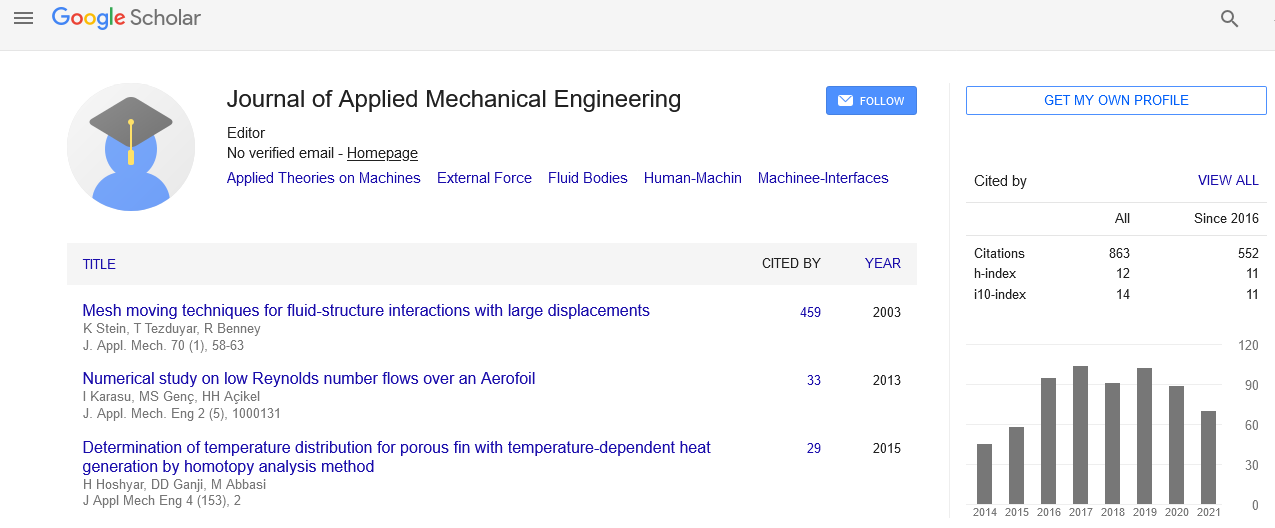Indexed In
- Genamics JournalSeek
- JournalTOCs
- CiteFactor
- RefSeek
- Hamdard University
- EBSCO A-Z
- OCLC- WorldCat
- Publons
- Google Scholar
Useful Links
Share This Page
Journal Flyer

Open Access Journals
- Agri and Aquaculture
- Biochemistry
- Bioinformatics & Systems Biology
- Business & Management
- Chemistry
- Clinical Sciences
- Engineering
- Food & Nutrition
- General Science
- Genetics & Molecular Biology
- Immunology & Microbiology
- Medical Sciences
- Neuroscience & Psychology
- Nursing & Health Care
- Pharmaceutical Sciences
Commentary - (2023) Volume 12, Issue 1
Mechanical Properties of Submerged Friction Stir Welding of Aluminum Alloys
Ravi Ayajiv*Received: 02-Jan-2023, Manuscript No. JAME-23-20844; Editor assigned: 05-Jan-2023, Pre QC No. JAME-23-20844; Reviewed: 19-Jan-2023, QC No. JAME-23-20844; Revised: 26-Jan-2023, Manuscript No. JAME-23-20844; Published: 03-Feb-2023, DOI: 10.35248/2168-9873.23.12.463
Description
As welding is one of the most commonly used techniques in the industry, researchers have devoted significant effort to developing high-quality welds. Despite numerous welding methods developed over the years, welding aluminum and its alloys remain challenging due to aluminum's strong heat conductivity and relatively low melting temperature. In addition, some marine engineering projects require underwater welding, like sea pipelines, ships, and marine platforms. Even though conventional welding methods such as arc welding can be used underwater, working with electric equipment underwater is generally considered particularly risky and challenging. Friction Stir Welding (FSW) is a newly developed technique that can solve both welding problems.
FSW has been the subject of extensive research since Wayne Thomas invented it at the Welding Institute UK in 1991. Earlier FSW welding procedures were limited to laboratory experiments to weld to 2xxx and 7xxx series aluminum alloys, which have limited weldability by conventional fusion welding procedures. As research progresses, friction stir welding is gaining popularity in welding almost all types of engineering materials. FSW can weld alloys like aluminum, steel, titanium, nickel, plastic, etc., with similar or dissimilar material joints with different welding configurations like butt, "T," lap type, fillet, etc. Friction stir welding is currently used in automobile, aerospace, naval, digital, and medical applications.
FSW is a very efficient solid-state joining method. In FSW, the work piece is welded below its melting point, thus avoiding voids caused by solidification, such as shrinkage, oxidation, porosity, and hydrogen solubility. FSW uses less energy, emits no gases, and doesn't require any consumable materials like electrodes, filler metals, or shielding gases. Furthermore, this welding process is free from arc flash, fumes, and spatter. Also, low heat input during the welding can reduce Inter-Metallic Compound (IMC) layer formation. In FSW, non-consumable profile tools consist of two major distinct parts, pin and shoulder. A rotary tool can be inserted into rigidly fixed welding specimens along the welding line. The tool is mounted on the spindle of the special-purpose machine, and the fixture is mounted on the bed. A rotating tool pin can be inserted into the abutting edges of the material to be welded by ensuring the shoulder is touched to the top surface of the material.
Conclusion
The detailed working procedure of the FSW. The tool can move along the weld line without melting the materials by combining heat from dissipating plastic with heat being created by this dissipation. As the material softens, the tool starts to move in a longitudinal direction along the weld line with sufficient speed. Tool traverse creates intensive plastic deformation along with mixing the plasticized flow of both sides of the material. It allows material transfer from the leading to the trailing side of the rotary tool. The tool shoulder restricts material from escaping from the weld, and its forging action ensures the welding of two materials. A pin probe is used to drive plasticized material onto the back of a pin while welding. A strong forging force is required to solidify the weld metal. The material undergoes significant plastic deformation during welding, resulting in dynamic recrystallization. The coalescence of pin-propelled flow and material propelled flow under the action of axial force by the welding tool in the weld nugget forms a strong welding joint by the FSW process.
Citation: Ayajiv R (2023) Mechanical Properties of Submerged Friction Stir Welding of Aluminum Alloys. J Appl Mech Eng. 12:463.
Copyright: © 2023 Ayajiv R. This is an open-access article distributed under the terms of the Creative Commons Attribution License, which permits unrestricted use, distribution, and reproduction in any medium, provided the original author and source are credited.

